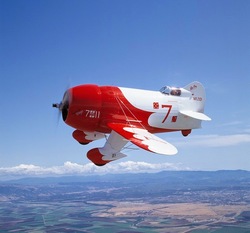Flying high
 An airplane, when in flight, is subjected to drag that is proportional to its speed
. But air flowing over the wings also pushes it downward. Given this consideration, we can model the total air resistance force on a plane as
for some constants
and
which depend on the airplane.
An airplane, when in flight, is subjected to drag that is proportional to its speed
. But air flowing over the wings also pushes it downward. Given this consideration, we can model the total air resistance force on a plane as
for some constants
and
which depend on the airplane.
Consider a plane that is in a steady flight at which the engine must provide an equal and opposite force to the resistance force. The speed at which the airplane flies the longest distance given a specific amount of fuel can be expressed as where and are positive integers. What is the value of ?
The answer is 5.
This section requires Javascript.
You are seeing this because something didn't load right. We suggest you, (a) try
refreshing the page, (b) enabling javascript if it is disabled on your browser and,
finally, (c)
loading the
non-javascript version of this page
. We're sorry about the hassle.
For the airplane to travel the longest distance given a specific amount of fuel to be consumed, the total air resistance must be minimized .
To minimize the total air resistance acting on the airplane, take the first derivative of the total air resistance with respect to the speed and set it to zero :
d v d F f = 0 = 2 a v − 2 b v − 3
Solving for v, we get v = ( a b ) 4 1 .
Equating the expression for v in v = ( K × a b ) M 1 , we have K = 1 and M = 4 . Therefore, the final answer is K + M = 5 .